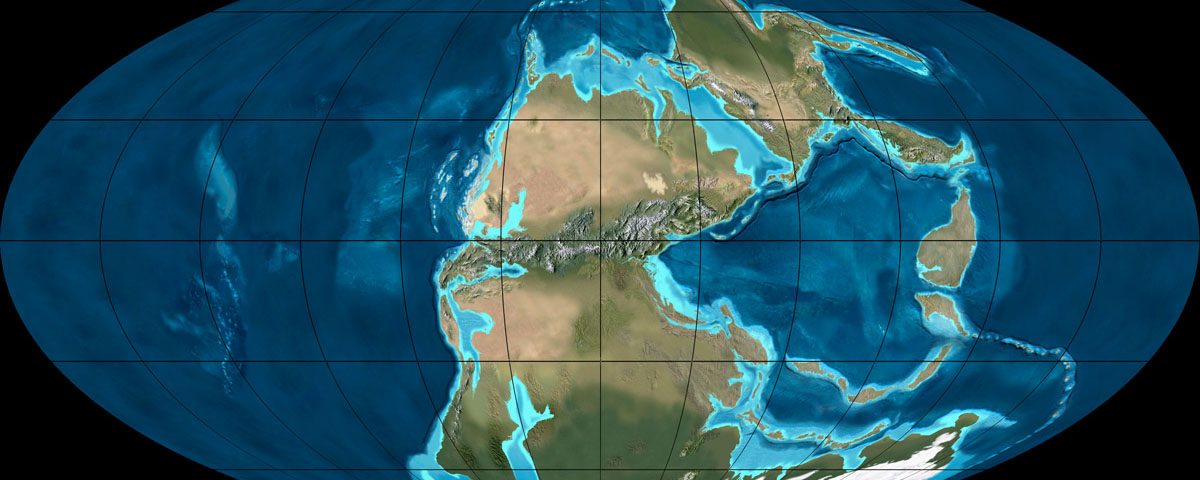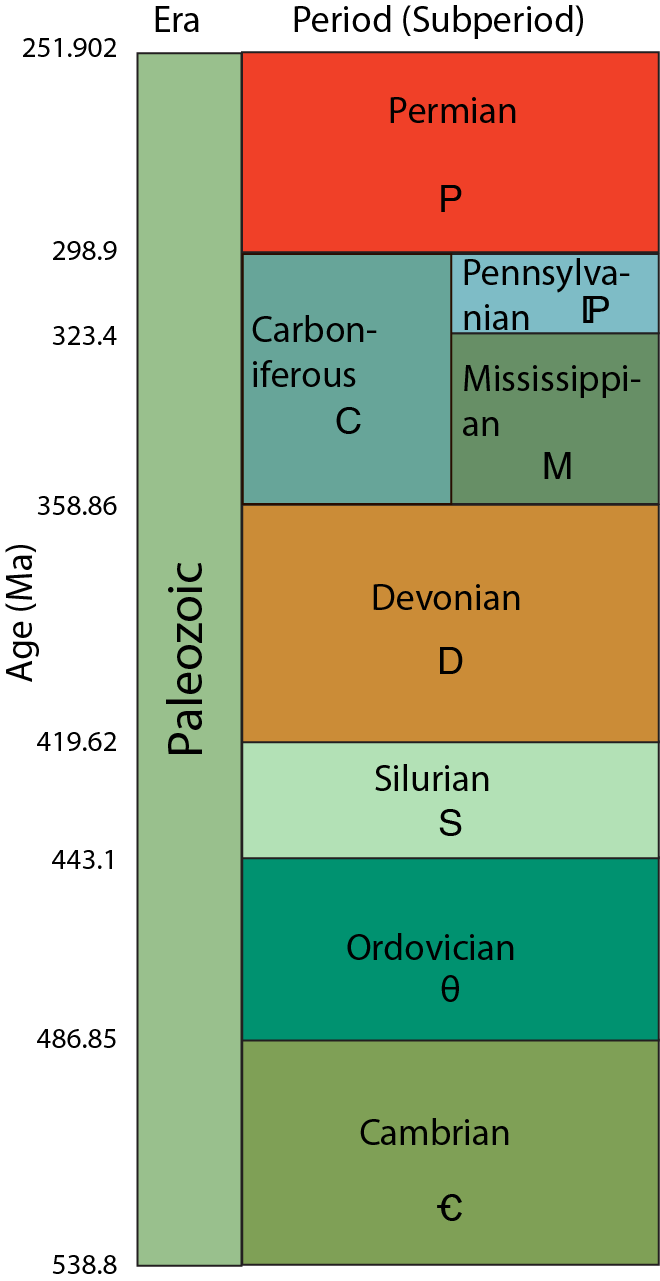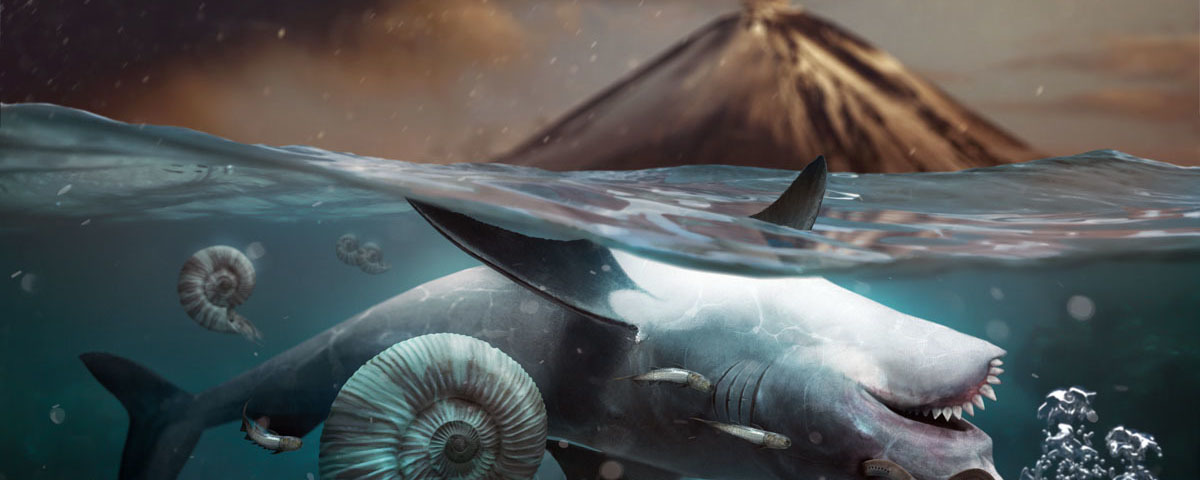



Phanerozoic Eon: 538.8 - 0 Ma
| Period | Range (Ma) |
|---|---|
| Permian | 298.9 - 251.902 |
| Carboniferous | 358.86 - 298.9 |
| OR Pennsylvanian | 323.4 - 298.9 |
| & Mississippian | 358.86 - 323.4 |
In traditional non-North American geology the (North American) Mississippian and Pennsylvanian Periods were not recognized; the Mississippian Period is thus the same as the traditional European Early Carboniferous Epoch and the Pennsylvanian Period is equivalent to the traditional European Late Carboniferous Epoch. In the latest international time scale, a compromise was reached, and the Mississippian and Pennsylvanian are "sub-periods" of the Carboniferous (each has three Epochs).
Paleogeography and Geology of the Mississippian:
Tabulate-stromatoporoid reefs disappear; related to switch from calcite seas to aragonite seas:
During Mississippian, no reef complexes of significance.
Huge carbonate banks in most shallow seas: crinoid meadows produce limestones whose main clasts are crinoid columnal elements.
Continued decline of CO2 -- sucked up into soils, and eventually coals -- lowers greenhouse effect, start of new series of Gondwanan glaciations. Non-reduced oxygen accumulates in the atmosphere.
During Late Mississippian, the Variscan Orogeny:
End of Mississippian: major regression, associated with mass extinction of some groups of stalked echinoderms and ammonoids.
Paleogeography and Geology of the Pennsylvanian:
Continued decline of CO2 (to just about modern levels!). O2 levels reach their maximum in Earth history (around or above 30%). Since N2 levels (which represent the majority of the atmosphere) would have likely remained constant, total atmospheric density reaches its highest in the age of blue skies (i.e., since the reducing atmosphere was oxidized).
As a consequence of this, forest fires become EXTREMELY easy to trigger. Also, higher O2 levels may have been the reason that very large terrestrial arthropods could live in the Carboniferous.
Continued glaciation in Gondwana: southern continents remain largely emergent.
Continued Collision of Gondwana and Euramerica:
Alleghanian Orogeny produced the direct "ancestor" of the modern Appalachians: the current mountains are the erosional remnants of the fold-and-thrust belt of the Alleghanian Appalachians.
Unusual cratonic deformation in southwestern Laurentia:
MOST IMPORTANT GEOLOGICAL EVENT OF PENNSYLVANIAN:
Formation of cyclothems
Some minor reefs formed by sponges, bryozoans, and algae.
Paleogeography and Geology of the Permian:
Increase in continental climates (extreme summers and winters, arid conditions) in many parts of the world, as Pangaea becomes more emergent.
In restricted basins, major evaporite deposits. Elsewhere, lots of eolian deposits.
CO2 levels begin to rise:
Collision between Siberia and northeastern Pangaea (former eastern part of Euramerica/Laurussia); Uralian Orogeny (Permian)
The Chinese blocks remain the only large cratons not attached to Pangaea.
Latest Permian and earliest Triassic:
Downwarped basins in what is now west Texas were bordered by big reef complexes (sponges, bryozoans, algae, brachiopds are main reef formers); otherwise, very few reefs from the Permian.
At very end (last half million years?) of Permian: Siberian Traps:
Others flourish: crinoids and blastoids do amazingly well, as do lacy bryozoans, brachiopods, ammonoids, sharks and actinopterygians.
Crinoid meadows: huge fields of crinoids and associated organisms.
Fusulinids: a type of foraminferan (armored single-celled eukaryote) appear: more important in Pennsylvanian.
Marine life of the Pennsylvanian:
Much as in Mississippian.
Fusulinids highly diverse, become important index fossils.
Marine life of the Permian:
Permian reef community: sponges and bryozoans as primary framework builders.
Brachiopods are extremely abundant, particularly large sediment sitters.
End of Permian: largest extinction in history of the marine realm
Major groups:
As the world began to dry out during the Late Pennsylvanian, scale tree and calamite forests decline as seed plant forests rise. Scale trees and cordaites die out at end of Pennsylvanian.
Permian flora:
Calamites die off in Early Permian.
Coal swamps decline over most of the world (not in China and in high latitudes of Pangaea).
Glossopteris: a "seed-fern" which was the most important member of the Glossopteris Flora of Gondwana. Adapted to upland, drier, cold environments.
Also, first ginkgos (not important until Triassic).
Conifers also diversity in Permian.
Arthropods on Land During the Carboniferous:
Arthropod diversity increases during Mississippian, but especially during Pennsylvanian (in concert with spread of forests). Some new aspects of Carboniferous arthropods:
Pennsylvanian arthropods include many gigantic forms:
Why so giant?
Permian terrestrial arthropods:
Few new groups, although the giant forms disappear.
The Permo-Triassic extinction is the ONLY mass extinction to effect insect diversity: sail through K/Pg extinction, etc., with no discernible effect, yet many clades killed off by Permo-Triassic event.
Other Terrestrial Invertebrates:
During later Paleozoic, freshwater snails and clams appear.
Late Paleozoic terrestrial vertebrates:
"Romer's Gap": few terrestrial stegocephalians between Late Devonian and Late Mississippian, as well as little diversity increase in arthropods at this time. Why the delay? Possibly a sampling issue, but it has been suggested that lower oxygen level may have held back terrestrial radiations.
High diversity of Late Carboniferous stegocephalians (many are true tetrapods):
Ecological breakthrough during Middle Pennsylvanian:
Amniotes divided into two main branches:
The synapsids were the first group to radiate (during the Early Permian), including such forms as:
These early synapsids would have had the sprawling stance found in primitive tetrapods in general. They almost certainly would have been "cold-blooded" (the ancestral state for vertebrates). So traditionally these animals have been considered "reptiles". However, they lack the shared derived features of reptiles (see below), and are instead simply primitive synapsids. (In traditional taxonomy, these were put in the group "Pelycosauria", but this is a paraphyletic group: all synapsids except for therapsids). New discoveries show that even early synapsids had some parental care.
The early synapsids evolved themselves into extinction: that is, they were replaced in the Middle and Late Permian Epoch by the Therapsida: the advanced synapsids. Once called the "mammal-like reptiles", they are not true reptiles. Instead, they are the advanced branch of the synapsid phylogeny. They differed from earlier synapsids by:
The Middle and Late Permian therapsids included:
Ancestrally, all vertebrates are cold-blooded (warm their bodies primarily using sunlight). However, some evidence suggests that the advanced therapsids of the Late Permian may have had elevated metabolisms (that is, were at least partially warm-blooded):
What is "warm-bloodedness"? Ectotherms ("cold-blooded" animals) get most of their heat from outside the body (mostly the sun). This is much less expensive in terms of metabolism, but it means that they are less active overall, grow slower, have slower recovery times after period of activity, and are limited to environments or times of day and year when they can get sufficient warmth from the sun. Endotherms ("warm-blooded" animals) generate most of their heat internally (from extra, leakier mitochondria) and have greater activity levels, grow faster, have quicker recovery times after periods of activity, and can live in colder environments. This comes at a cost, however: to fuel their bodies, they need as much as ten times the amount of food of an ectotherm of the same body size.
Additionally, some therapsids seem to have had parental care of the young, keeping them in burrows.
True sauropsids tended to be relatively rare in the Carboniferous and Permian Periods. Sauropsida is characterized by a number of particular skeletal features (which we aren't going to deal with here, as they are fairly technical). Modern sauropsids (and by inference, their concestor and all of its descendants) share a number of soft-tissue features:
In general, compared to typical Mesozoic and Cenozoic ecosystems, the late Paleozoic land vertebrates were smaller (few ox- or hippo-sized, none larger), slower (no real speed specialists), and close to the ground (only a few gliders and no powered fliers; few tree-climbing specialists).
The Permo-Triassic Extinction:
Largest mass extinction of Phanerozoic. Total of all Permo-Triassic events may be 80-96% of species (or, in the flip side, only 4-20% of species survived)
Victims include:
Was once thought to be gradual (extended over 9 Myr), but now seems be in two main pulses (or maybe just even one!). Some evidence suggests that there is a first pulse, between the Capitanian Age of the Guadalupian ("Middle Permian") Epoch and the Wuchiapingian Age of the Lopingian ("Late Permian") Epoch. It was smaller, but still powerful: 34% genus level extinction in the seas (comparable to the Cretaceous-Paleogene extinction!) and fairly powerful on land, too. The event showed a marked reduction of members of the Paleozoic fauna, but not the loss of entire major clades. (However, some statistical evidence suggests that this may not be a real event, and that all extinction is concentrated at the end of the Changhsingian.)
The BIG ONE is at the end of the Changhsingian Age of the Lopingian Epoch, was the worst mass extinction in the history of multicellular life:
It wouldn't have been the lava that caused the extinction, however. Instead the gasses emitted were the primary causes. First and foremost is the carbon dioxide release, producing some of the most extreme global warming in Earth's history. Today (2018) there is about 873 Gt (gigatons) of C (carbon) in our atmosphere, reflecting about 410 parts per million CO2 (1 ppm = 2.13 Gt C). Before the Industrial Revolution, that value was around 600 Gt C. The Siberian Traps dwarfed these values by several orders of magnitude. Initial estimates were that over the course of the eruptions about 12,000-18,000 Gt C were released; newer modeling points to values closer to a mind-staggering 170,000 Gt C!! This didn't happen as a single burst, so there was no moment when Earth's atmosphere had 80,000 ppm CO2 during this interval, but it was still tremendously higher than today (or, more important for this issue, compared to the time before the extinction. Values aren't certain, but carbon dioxide levels had an increase of at least 8 times, and possibly more! This lead to extreme global warming (surface temperatures rising by more than 7°C, possibly much more), which lead to warming of the sea floor, which lead to melting of the methane clathrates (methane frozen in ice on the sea floor), which bubbled into the atmosphere, which led to even more global warming. The oceans would also become more acidic because of the carbon dioxide mixing with water, causing damage to shell-forming organisms.
Additionally, the new studies point to as much as 18,000 Gt HCl (that's hydrochloric acid!) being released by the melting of underground rock salt deposits. Between the HCl, sulfuric acid (a byproduct of sulfur dioxide, a common component of eruptions), and carbon dioxide there would likely have been catastrophic levels of acid rain and oceanic acidification, worldwide.
Additionally, there were tremendous drops in atmospheric and oceanic O2 due to the mass death of so many land plants and phytoplankton and to oxidation of the methane. To make matters worse, increases in global temperature would decrease the temperature differential around the world, decreasing oceanic and atmospheric circulation, and thus reducing the churning up and oxygenation of the ocean water.
A consequence of the ocean anoxia is the promotion of sulfur bacteria. These prokaryotes prefer anoxic and dysoxic conditions. Their photosynthesis does not release oxygen as a waste product; instead, they release hydrogen sulfide (H2S), a gas highly poisonous to both aquatic and land animals. With shallow sunlit water devoid of their oxygen-generating competitors, the purple bacteria spewed out hydrogen sulfide, further making the shallow seas and land a hellish condition for other life.
But wait, there's more! The sulfates ejected by the eruptions and the H2S from the bacteria can destroy ozone. As these gases made their way into the higher atmosphere, the Earth lost its protection from dangerous UV radiation reaching the surface. Malformed pollen had already been known from latest Permian rocks; a recent experimental study showed that these malformations can be produced by subjecting plants of the same general groups present in the Permian with high levels of UV. Such malformations would greatly decrease plant fertility. (On top of that, the UV can kill the plants themselves, as well as animals.)
Stratigraphic evidence demonstrates that the main pulse of extinction took a mere 60 kyr, plus or mins 48 kyr, to occur!
And keep in mind, these killing agents are produced independent of living things. The eruptions would continue for 100s of kyrs, so that there would be long slow recovery for the atmosphere, ocean, and pedosphere (soil). This meant that the ecosystems continued to suffer for millions of years.
Regardless of precise scenario, extinction reorganizes the world. After the event, the Paleozoic marine evolutionary fauna becomes subordinate to the Modern marine evolutionary fauna. Also, the size and diversity of the animals present is greatly reduced.
Some basic patterns of extinction vs. survivorship:
Giant arthropods of the Coal Swamps:
The Tully Monster:
The Buzzsaw shark Helicoprion:
The early synapsid Dimetrodon (not an ACTUAL mammal ancestor, but a protomammal nonetheless):
A video explaining the Siberian Traps:
To Lecture Notes.
